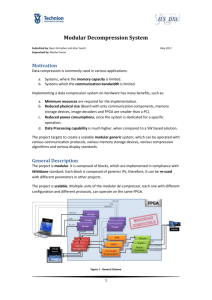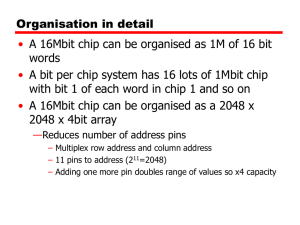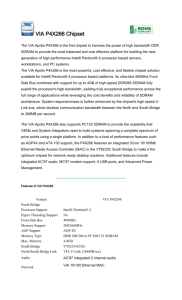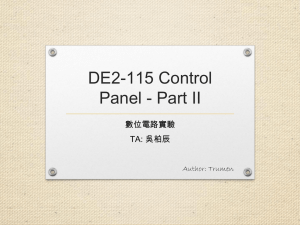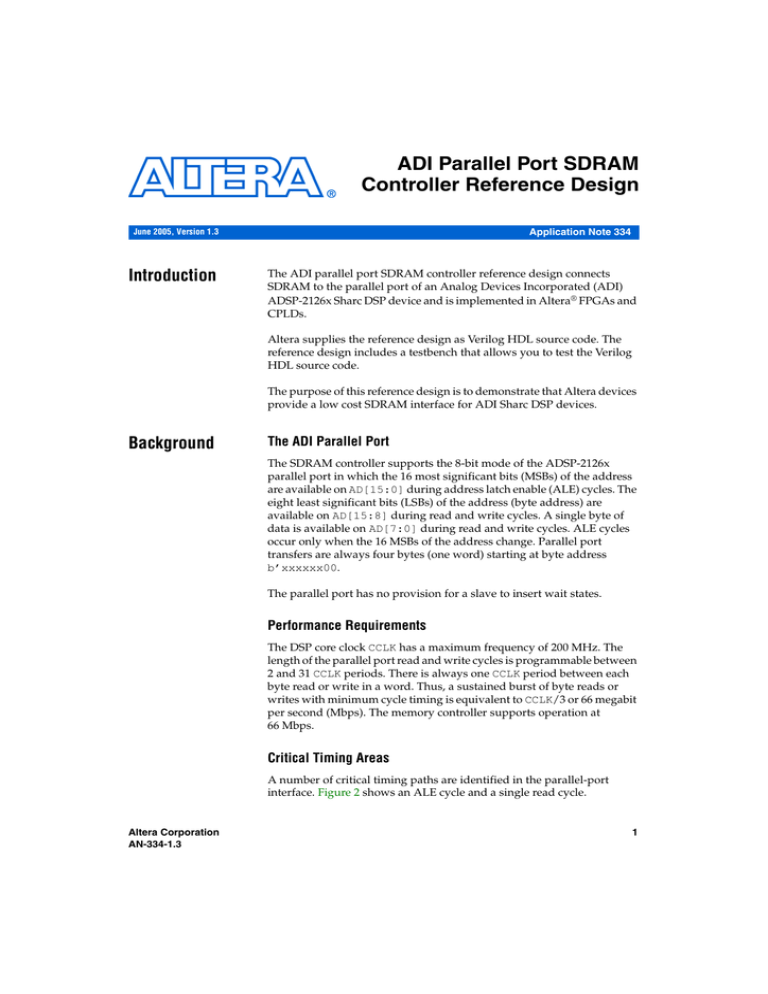
ADI Parallel Port SDRAM
Controller Reference Design
Application Note 334
June 2005, Version 1.3
Introduction
The ADI parallel port SDRAM controller reference design connects
SDRAM to the parallel port of an Analog Devices Incorporated (ADI)
ADSP-2126x Sharc DSP device and is implemented in Altera® FPGAs and
CPLDs.
Altera supplies the reference design as Verilog HDL source code. The
reference design includes a testbench that allows you to test the Verilog
HDL source code.
The purpose of this reference design is to demonstrate that Altera devices
provide a low cost SDRAM interface for ADI Sharc DSP devices.
Background
The ADI Parallel Port
The SDRAM controller supports the 8-bit mode of the ADSP-2126x
parallel port in which the 16 most significant bits (MSBs) of the address
are available on AD[15:0] during address latch enable (ALE) cycles. The
eight least significant bits (LSBs) of the address (byte address) are
available on AD[15:8] during read and write cycles. A single byte of
data is available on AD[7:0] during read and write cycles. ALE cycles
occur only when the 16 MSBs of the address change. Parallel port
transfers are always four bytes (one word) starting at byte address
b’xxxxxx00.
The parallel port has no provision for a slave to insert wait states.
Performance Requirements
The DSP core clock CCLK has a maximum frequency of 200 MHz. The
length of the parallel port read and write cycles is programmable between
2 and 31 CCLK periods. There is always one CCLK period between each
byte read or write in a word. Thus, a sustained burst of byte reads or
writes with minimum cycle timing is equivalent to CCLK/3 or 66 megabit
per second (Mbps). The memory controller supports operation at
66 Mbps.
Critical Timing Areas
A number of critical timing paths are identified in the parallel-port
interface. Figure 2 shows an ALE cycle and a single read cycle.
Altera Corporation
AN-334-1.3
1
Preliminary
ADI Parallel Port SDRAM Controller Reference Design
Background
Figure 1. Read Cycle Timing
ALE
tALEW
tRW
RD
WR
tADAS
tALEHZ
tADRH
tADAH
AD[15:8]
tDAD
tDRS
tDRH
AD[7:0]
Table 1 shows the minimum read cycle timing parameters for 66-Mbps
operation.
Table 1. Minimum Read Cycle Timing Parameters for 66 Mbps
Parameter
Time (ns)
tALEW
8
tRW
8
tDAD
9
tDRS
3.3
The ALE strobe is asynchronous with a guaranteed maximum width,
tALEW, of 8 ns. Read and write strobes are asynchronous. For 66 Mbps they
have a guaranteed minimum width, tRW, of 8 ns. The minimum period for
which read and write strobes is de-asserted is not specified but is
assumed to be approximately one CCLK period or 5 ns. To use the strobes
synchronously, a local clock in excess of 400 MHz is required to double
sample the negation of the read and write strobes between each byte.
If the strobes are used asynchronously, only 5.78 ns is available for the
output enable during read cycles. To select read data from the byte
address, 10ns (tDAD) is available.
2
Preliminary
Altera Corporation
Background
ADI Parallel Port SDRAM Controller Reference Design
If the rising edge of each read strobe is used as a clock for the next read
data, 13 ns (3 × CCLK period – tDAD) is available as the tCO for selection of
the next read data byte.
SDRAM Requirements
SDRAM requires initialization, periodic refresh, page open, and page
close (precharge) cycles in addition to read and write cycles. The lack of a
wait mechanism on the parallel port requires that all access to SDRAM by
the parallel port complete in the same fixed number of cycles. Refresh and
page operations must not interfere with data accesses.
Refresh and page open and close operations are scheduled in software by
the DSP and initiated through a register set within the SDRAM controller.
This is acceptable as the DSP is expected to be running an algorithm in a
regular well-timed execution loop with a priori knowledge of what data
movements are required (allowing the correct page to be opened for
reading or writing) and when the data is required (allowing refreshes to
be scheduled). Initialization is a once only operation following reset and
is also initiated through the register set.
Resource Requirements
Table 2 shows resource requirements and their advantages and
disadvantages.
Table 2. Resource Requirements
Family
Advantage
Disadvantage
Macrocells
/LEs
MAX® II
Slowest speed grade is sufficient. Instant
on.
–
266
MAX
Instant on.
Requires the fastest speed grade.
234
Cyclone™
Slowest speed grade is sufficient.
Space in smallest device to integrate
system glue logic.
Requires configuration.
265
Supported Devices
The SDRAM controller supports 128-Mbit byte-wide SDRAM, e.g.,
Micron MT48LC16M8A2.
1
Altera Corporation
The reference design can be modified to support other memory
sizes.
3
Preliminary
ADI Parallel Port SDRAM Controller Reference Design
Functional
Description
Functional Description
Figure 2 shows the block diagram.
Figure 2. Block Diagram
Reference Design
Control
Write
Buffer
Control
Parallel
Port
Interface
SDRAM
Interface
SDRAM
Data
Read
Buffer
Data
Address
Registers
Clock
Registers
SDRAM controller registered are accessed in the highest 256 bytes of the
parallel port address space selected by an ALE cycle with AD[15:0] =
0xffff. Table 3 shows the SDRAM controller register memory map. All
registers are write only.
Table 3. SDRAM Controller Registers
Register
Address
Description
INIT
0xffff00
The SDRAM will be initialized by a parallel port write to the INIT register.
REFRESH
0xffff04
A parallel port write to the REFRESH register will cause a burst of 8 auto
refresh cycles to be performed.
OPEN_READ
0xffff08
A bank opens for reading by performing a parallel port write to the
OPEN_READ register. The data written to the register will specify the row
address, bank address and starting column address bits for the location to
be accessed by subsequent read operations.
OPEN_WRITE
0xffff0c
A bankopens for writing by performing a parallel port write to the
controllers OPEN_WRITE register. The data written to the register will
specify the row address, bank address and starting column address bits
for the location to be accessed by subsequent write operations.
4
Preliminary
Altera Corporation
Functional Description
ADI Parallel Port SDRAM Controller Reference Design
Table 3. SDRAM Controller Registers
Register
Address
Description
POWER_DOWN
0xffff10
A parallel port write to the POWER_DOWN register will put the SDRAM
into power down mode.
POWER_UP
0xffff14
A parallel port write to the POWER_UP register will put the SDRAM into
idle mode redy for a page to be opened for reading or writing.
Table 3 shows the bit fields for the OPEN_READ and OPEN_WRITE
registers..
Table 4. OPEN_READ and OPEN_WRITE Register Format
Bits
Description
31:24
Unused—write 0
23:12
Row address
11:10
Bank address
9:0
Column address
Operation
This sections describes the following operations
■
■
■
■
■
Initialization
Refresh
Write accesses
Read accesses
Power down
Initialization
A parallel port write to the INIT register causes the SDRAM controller to
perform the following operations:
■
■
■
precharge all
two auto refresh cycles
load mode register
The BUSY output of the SDRAM controller asserts whilst these operations
are being performed (see Figure 3).
No other accesses are allowed to the SDRAM controller whilst BUSY is
asserted.
Altera Corporation
5
Preliminary
ADI Parallel Port SDRAM Controller Reference Design
Functional Description
Figure 3. SDRAM Initialization
Refresh
A parallel port write to the REFRESH register causes a precharge all
command to be issued to the SDRAM followed by a burst of eight autorefresh commands. The BUSY output of the SDRAM controller is asserted
whilst the refreshes are being performed (see Figure 4).
No other accesses are allowed to the SDRAM controller whilst BUSY is
asserted.
Figure 4. SDRAM Refresh Burst
6
Preliminary
Altera Corporation
Functional Description
ADI Parallel Port SDRAM Controller Reference Design
Write Accesses
Writing to the OPEN_WRITE register causes a precharge all command to
be issued to the SDRAM followed by an active command for all banks at
the specified row address. When an SDRAM bank has been opened for
writing, write data is pipelined through the controller, which gives the
appearance of operating at the parallel ports maximum rate of 66 Mbps.
Write access are allowed to random bank or column addresses (see
Figures 5 and 6).
Figure 5. SDRAM Write Bank Opening
Figure 6. SDRAM Write Cycles
Altera Corporation
7
Preliminary
ADI Parallel Port SDRAM Controller Reference Design
Functional Description
Read Accesses
Writing to the OPEN_READ register causes a precharge all command to be
issued to the SDRAM followed by an active command for all four banks
at the specified row address. When an SDRAM bank has been opened for
reading, the SDRAM exhibits latency from issuing of each read command
to the required data being returned. To remove the effect of this latency,
the controller prefetches data and imposes strict rules on read access
patterns allowed via the parallel port. Opening a bank for reading causes
data to be prefetched from the SDRAM, starting at bank or column
address specified, into an internal buffer. Each subsequent read returns
the prefetched data to the parallel port and prefetch new data for a further
read. Thus, data is always read from successive locations in all banks,
wrapping around from the end of bank3 to the start of bank0, regardless
of the byte address on AD[15:8] (see Figures 7 and 8).
Figure 7. SDRAM Read Bank Opening & Prefetch
8
Preliminary
Altera Corporation
Functional Description
ADI Parallel Port SDRAM Controller Reference Design
Figure 8. SDRAM Read Cycles & Prefetch
Power Down
The SDRAM may be powered down by a performing a parallel port write
to the POWER_DOWN register. The SDRAM must be powered up again (by
writing to the POWER_UP register) for refresh at the scheduled interval.
The SDRAM clock enable (CKE) is driven low to put the device into power
down mode. If the SDRAM was previously open for reading or writing,
issue a refresh burst before the power down.
The SDRAM must be powered up (by writing to the POWER_UP register)
before further operations take place. Attempting to write to the SDRAM
whilst in power down results in loss of data. Attempting to read returns
undefined data. Figure 5 shows power down and power up.
Altera Corporation
9
Preliminary
ADI Parallel Port SDRAM Controller Reference Design
Getting Started
Figure 9. Power Down & Power Up
Getting Started
This section involves the following steps:
1.
“Software Requirements”.
2.
“Install the Design”.
Software Requirements
The reference design requires the Quartus® II software version 4.2, or
higher.
Install the Design
To install the reference design, run the .exe and follow the installation
instructions. Figure 10 shows the directory structure.
10
Preliminary
Altera Corporation
Getting Started
ADI Parallel Port SDRAM Controller Reference Design
Figure 10. Directory Structure
adi-sdram
build
Contains the Quartus directory.
quartus
Contains the Quartus project file and constraints.
doc
Contains the documentation files.
source
Contains the source file directory.
verilog
Contains the Verilog HDL source files.
test
Contains the harness directory.
harness
Contains testbench directory.
sdram
Contains the SDRAM simulation model.
tb
Contains the ModelSim project files and testbench Verilog HDL source files.
101 Innovation Drive
San Jose, CA 95134
(408) 544-7000
www.altera.com
Applications Hotline:
(800) 800-EPLD
Literature Services:
literature@altera.com
Altera Corporation
Copyright © 2005 Altera Corporation. All rights reserved. Altera, The Programmable Solutions Company,
the stylized Altera logo, specific device designations, and all other words and logos that are identified as
trademarks and/or service marks are, unless noted otherwise, the trademarks and service marks of Altera
Corporation in the U.S. and other countries. All other product or service names are the property of their respective holders. Altera products are protected under numerous U.S. and foreign patents and pending
applications, maskwork rights, and copyrights. Altera warrants performance of its semiconductor products
to current specifications in accordance with Altera's standard warranty, but reserves the right to make changes to any products and services at any time without notice. Altera assumes no responsibility or liability
arising out of the application or use of any information, product, or service described
herein except as expressly agreed to in writing by Altera Corporation. Altera customers
are advised to obtain the latest version of device specifications before relying on any published information and before placing orders for products or services.
11
Preliminary

